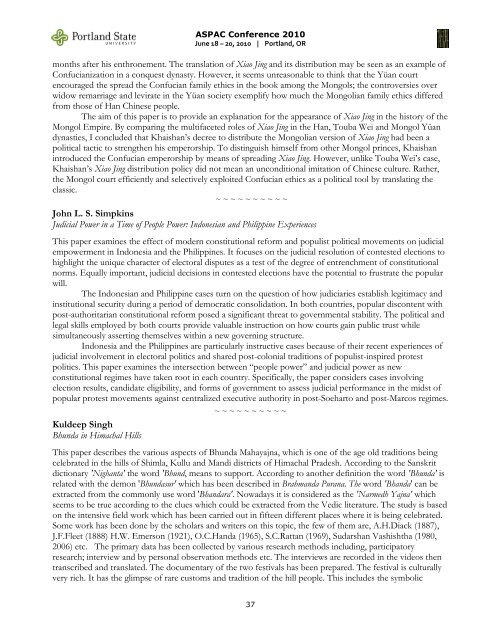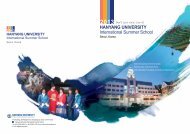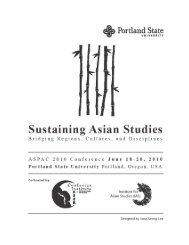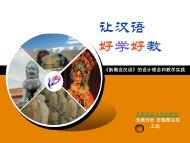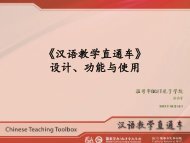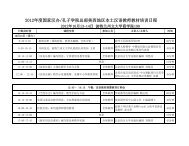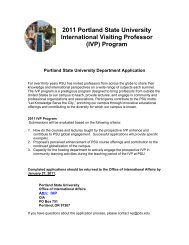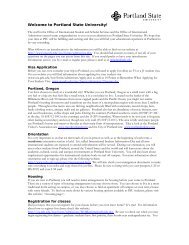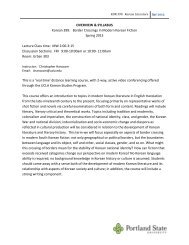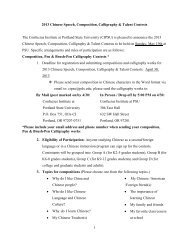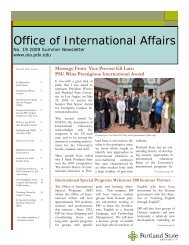ABSTRACTS - oia - Portland State University
ABSTRACTS - oia - Portland State University
ABSTRACTS - oia - Portland State University
You also want an ePaper? Increase the reach of your titles
YUMPU automatically turns print PDFs into web optimized ePapers that Google loves.
ASPAC Conference 2010<br />
June 18 – 20, 2010 | <strong>Portland</strong>, OR<br />
months after his enthronement. The translation of Xiao Jing and its distribution may be seen as an example of<br />
Confucianization in a conquest dynasty. However, it seems unreasonable to think that the Yüan court<br />
encouraged the spread the Confucian family ethics in the book among the Mongols; the controversies over<br />
widow remarriage and levirate in the Yüan society exemplify how much the Mongolian family ethics differed<br />
from those of Han Chinese people.<br />
The aim of this paper is to provide an explanation for the appearance of Xiao Jing in the history of the<br />
Mongol Empire. By comparing the multifaceted roles of Xiao Jing in the Han, Touba Wei and Mongol Yüan<br />
dynasties, I concluded that Khaishan’s decree to distribute the Mongolian version of Xiao Jing had been a<br />
political tactic to strengthen his emperorship. To distinguish himself from other Mongol princes, Khaishan<br />
introduced the Confucian emperorship by means of spreading Xiao Jing. However, unlike Touba Wei’s case,<br />
Khaishan’s Xiao Jing distribution policy did not mean an unconditional imitation of Chinese culture. Rather,<br />
the Mongol court efficiently and selectively exploited Confucian ethics as a political tool by translating the<br />
classic.<br />
~ ~ ~ ~ ~ ~ ~ ~ ~ ~<br />
John L. S. Simpkins<br />
Judicial Power in a Time of People Power: Indonesian and Philippine Experiences<br />
This paper examines the effect of modern constitutional reform and populist political movements on judicial<br />
empowerment in Indonesia and the Philippines. It focuses on the judicial resolution of contested elections to<br />
highlight the unique character of electoral disputes as a test of the degree of entrenchment of constitutional<br />
norms. Equally important, judicial decisions in contested elections have the potential to frustrate the popular<br />
will.<br />
The Indonesian and Philippine cases turn on the question of how judiciaries establish legitimacy and<br />
institutional security during a period of democratic consolidation. In both countries, popular discontent with<br />
post-authoritarian constitutional reform posed a significant threat to governmental stability. The political and<br />
legal skills employed by both courts provide valuable instruction on how courts gain public trust while<br />
simultaneously asserting themselves within a new governing structure.<br />
Indonesia and the Philippines are particularly instructive cases because of their recent experiences of<br />
judicial involvement in electoral politics and shared post-colonial traditions of populist-inspired protest<br />
politics. This paper examines the intersection between “people power” and judicial power as new<br />
constitutional regimes have taken root in each country. Specifically, the paper considers cases involving<br />
election results, candidate eligibility, and forms of government to assess judicial performance in the midst of<br />
popular protest movements against centralized executive authority in post-Soeharto and post-Marcos regimes.<br />
Kuldeep Singh<br />
Bhunda in Himachal Hills<br />
~ ~ ~ ~ ~ ~ ~ ~ ~ ~<br />
This paper describes the various aspects of Bhunda Mahayajna, which is one of the age old traditions being<br />
celebrated in the hills of Shimla, Kullu and Mandi districts of Himachal Pradesh. According to the Sanskrit<br />
dictionary 'Nighanta' the word 'Bhund, means to support. According to another definition the word 'Bhunda' is<br />
related with the demon 'Bhundasur' which has been described in Brahmanda Purana. The word 'Bhanda' can be<br />
extracted from the commonly use word 'Bhandara'. Nowadays it is considered as the 'Narmedh Yajna' which<br />
seems to be true according to the clues which could be extracted from the Vedic literature. The study is based<br />
on the intensive field work which has been carried out in fifteen different places where it is being celebrated.<br />
Some work has been done by the scholars and writers on this topic, the few of them are, A.H.Diack (1887),<br />
J.F.Fleet (1888) H.W. Emerson (1921), O.C.Handa (1965), S.C.Rattan (1969), Sudarshan Vashishtha (1980,<br />
2006) etc. The primary data has been collected by various research methods including, participatory<br />
research; interview and by personal observation methods etc. The interviews are recorded in the videos then<br />
transcribed and translated. The documentary of the two festivals has been prepared. The festival is culturally<br />
very rich. It has the glimpse of rare customs and tradition of the hill people. This includes the symbolic<br />
37


